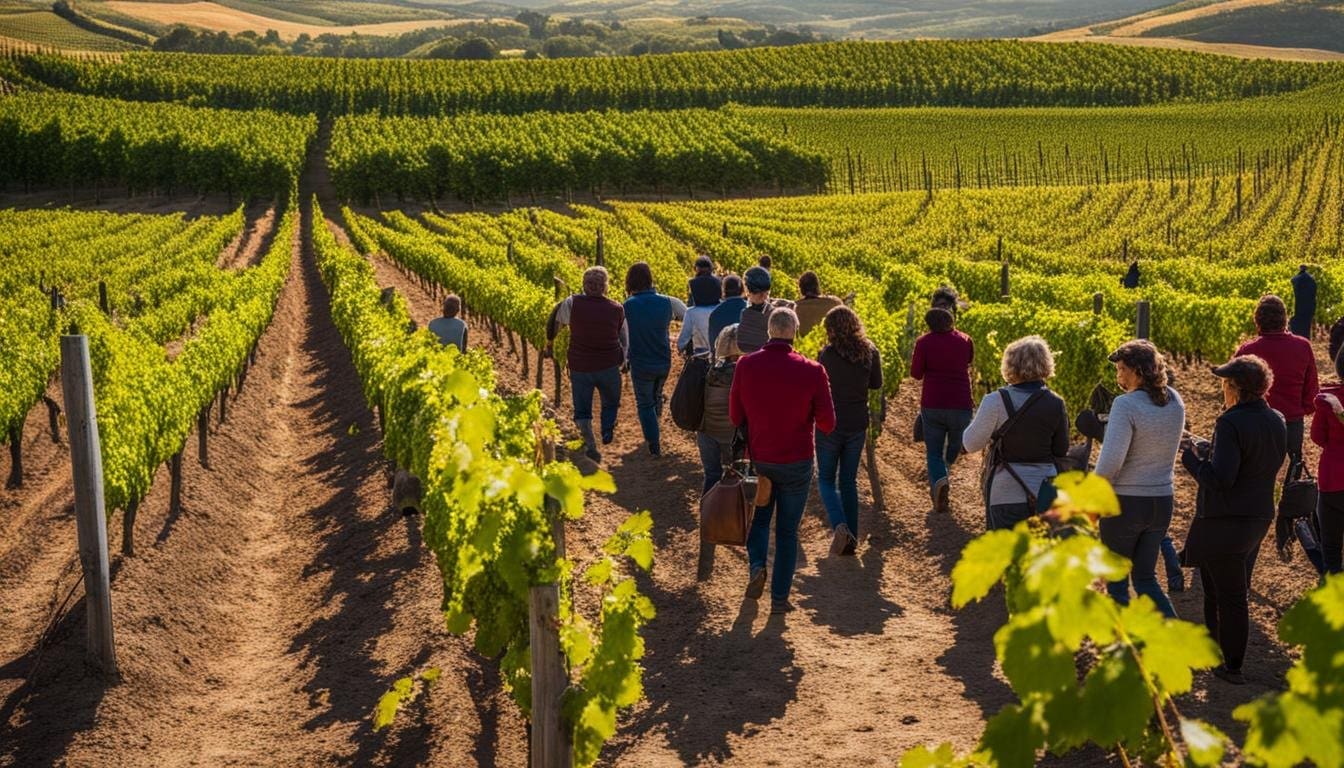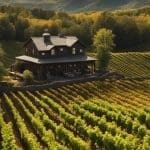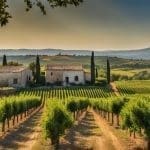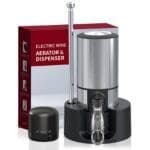As a seasoned lover of fine wines, I reckon there’s nothing quite like the rich tapestry of a well-crafted Spanish red to transport you straight to the heart of the storied vineyards from where it hails. Today, I’m chuffed to share my insights on a region that’s a cracker of a spot for any self-respecting oenophile – the Ribera del Duero. Known for its top-notch Ribera del Duero wine, this Spanish treasure is bursting with history, flavour, and a vivacious spirit that endears it to wine enthusiasts like you and me.
A stroll through the sun-drenched vineyards, glass in hand, is more than a tour; it’s a pilgrimage for the palate. The star of the show, Tempranillo, ripens under the golden Iberian sun to offer a bounty that’s both robust and refined. Through vineyard tours and wine exploration, I’ve come to appreciate Ribera del Duero’s wine as not just a beverage but a narrative of the land’s heritage and the fervour of its winemakers.
I invite you to join me on this vinous journey, where every sip speaks the language of the Spanish soil. Ready your senses, for the Ribera del Duero is not just any Spanish red wine – it’s a revelation.
Key Takeaways
- Experience the Ribera del Duero wine, a crown jewel in the world of Spanish red wine.
- Take a gander at the ancient winemaking traditions through immersive vineyard tours.
- Get to grips with Tempranillo, the region’s standout grape, and delve into its unique local character.
- Embrace the chance to go beyond the bottle and indulge in hands-on wine exploration.
- Discover how Ribera del Duero has etched its name in the annals of wine history with a legacy of exceptional vintages.
Discovering Ribera del Duero’s Winemaking Heritage
As a devotee of Spanish wine, I’m perpetually intrigued by the legacies behind each bottle. The discovery of Ribera del Duero’s winemaking heritage is akin to unearthing a hidden narrative etched in vineyard soils. The region’s historic evolution from monastic vineyards to world-renowned wine havens encapsulates centuries of dedication and mastery of viticultural arts.
The Birthplace of Exceptional Tempranillo
The heart of Ribera del Duero’s viticultural acclaim pulsates through the venerable Tempranillo grape—a variety that’s become synonymous with quality Spanish reds. This grape, nurtured in the cradle of an ancient winemaking heritage, has benefited from the hands of artisans who’ve passed down knowledge through generations. The monks may have left, but the sacredness of their practices remain, as illustrated by the lauded lineage of wines from producers such as Vega Sicilia.
Geographical Influence: The High Plateaus and the Duero River
The region’s geography is a tapestry of elevated plateaus and the meandering Duero River, both carving a niche where the Tempranillo grape prospers. Rising above sea level, the altitude bestows profound diurnal temperature variations, instilling the vines with resilience resulting in wines marked by vibrant acidity and a robust structure so often celebrated globally.
The Impact of Climate on Ribera del Duero’s Vineyards
The Mediterranean climate, with its hot summers and brisk winters, is both a challenge and a charmed envoy for viticulture here. The temperature extremes demand tenacity from both vine and vintner, yet it’s within this climatic crucible that the essence of Ribera del Duero wine is forged. Renowned winemakers like Alejandro Fernández understood this dance with nature, leveraging the climate to produce red wines with a balance of power and finesse—exemplars of the prestigious winemaking heritage that is Ribera del Duero.
Ribera del Duero Wine: A Journey Through Flavors and Aromas
Embarking on a Ribera del Duero wine exploration is akin to a sensual odyssey, where each sip reveals a complex tapestry of wine flavors and complex aromas. As a lover of finely crafted reds, I find myself captivated by the rich, full-bodied character of these Spanish jewels. Notably, the Tempranillo varieties stand out, offering a sensory feast that is as deep and alluring as the vineyards themselves.
Gleaming in the glass with an intense ruby color, Ribera del Duero wines encapsulate the region’s commitment to red wine aging, an art that is perfected over time. The dance between ripened fruit and seasoned wood creates an experience that resonates with grace. It’s here where flavors of blackberry and plum meld seamlessly with the spicy undertones of vanilla and tobacco, a hallmark of skilled craftsmanship.
| Variety | Tasting Notes | Aging Potential |
|---|---|---|
| Tempranillo | Blackberry, cassis, red berries, vanilla | 10-20 years |
| Cabernet Sauvignon Blend | Herbaceous, black fruit, leather | 15-25 years |
| Merlot Mix | Plum, tobacco, spice | 12-22 years |
| Malbec Combination | Earthy, dark berries, mocha | 10-18 years |
Each glass of Ribera del Duero beckons with the promise of discovery—whether it’s your first encounter or your hundredth, the complex aromas and rich palette of wine flavors serve as an unspoken invitation to indulge. I relish in the never-ending journey, where every vintage is a story of its landscape, waiting to be savored and shared. As I cherish the nuances of each variety, from the stalwart Tempranillo to its harmonious blends, I am struck by the elegance etched in every bottle, a tribute to the noble tradition of red wine aging. Indeed, the wines of Ribera del Duero are not merely beverages; they are an experience to be treasured, a gateway to the heart of Spanish viticulture.
Conclusion
In the verdant expanses of Spain’s Ribera del Duero, there’s a stirring of tradition that’s been continuously cultivated since ancient times and, today, finds a new audience in Australia. Reflecting on the myriad tastings and countless vineyards, I realise that the Australian market’s keen interest in fine wine investment is well-matched with this storied region’s offerings. Ribera del Duero wine, with its complexity and elegance, deserves the growing attention it’s receiving from connoisseurs and newcomers alike on Australian soil. The future looks promising, as more Australians discover and embrace the remarkable diversity that Spanish wine brings.
The Future of Ribera del Duero Wines in Australia
The trajectory for Ribera del Duero wine in Australia is one I view with excitement. My palate has been captivated by their robust flavours and sophistication, which seem to resonate well with the Australian penchant for wines with depth and character. As a fine wine investment, these Spanish reds hold potential not only for pleasure but also as a testament to the rich heritage and winemaking prowess contained in every bottle. It’s a union of two distant lands with a shared appreciation for extraordinary vintages.
Celebrating the Diversity of Spanish Wine
The diversity of Spanish wine, particularly from the Ribera del Duero region, is indeed something to be celebrated. It’s the diversity in their Tempranillo expressions — from lively, accessible vintages to age-worthy epitomes of vinous art — that keeps my interest piqued. There’s a deep satisfaction in knowing that such complexity in aroma and flavour profile stems from a place with rich historical layers, and now, finding its way to Australian palates, it seems like a new chapter of appreciation is just beginning. Here’s to embracing the tapestry of tastes that Ribera del Duero so masterfully weaves, and to the future stories it will tell in glasses across Australia.
FAQ
What is Ribera del Duero wine, and how does it stand out within Spanish red wine?
Ribera del Duero wine is a distinguished expression of Spanish red wine, primarily made from the Tempranillo grape, or Tinto Fino as it’s locally known. It stands out due to its full-bodied nature, deep color, and complex flavors that are a direct reflection of the region’s unique terroir and winemaking history that dates back thousands of years.
How do vineyard tours contribute to the wine exploration experience in Ribera del Duero?
Vineyard tours in Ribera del Duero offer an immersive experience, providing a hands-on opportunity to understand the winemaking process, the geographical nuances, and the agricultural practices that contribute to the character of the wines produced there. Visitors can also taste and appreciate the wine in the very setting where it’s made.
What is it about the Tempranillo grape that makes it so significant to Ribera del Duero?
The Tempranillo grape, known locally as Tinto Fino, is the heart of Ribera del Duero’s winemaking. This grape variety adapts well to the harsh climatic conditions and the varied soils of the region. It is renowned for its ability to produce robust, age-worthy wines with a balance of fruit and earthy flavors.
Can you explain the geographical influences that shape the unique character of Ribera del Duero wines?
Certainly! The Ribera del Duero region is marked by its high plateaus and the Duero River, which help moderate the extreme climate conditions. The mixed sandy soils, often with chalk and limestone, contribute minerality to the wines, while the altitude and diurnal temperature shifts enhance the acidity and flavor complexity of the grapes.
How does the climate in Ribera del Duero affect the vineyards and the quality of the wine produced?
The Ribera del Duero region experiences a continental Mediterranean climate with cold winters and hot summers, along with significant temperature shifts between day and night. These conditions stress the vines in a beneficial manner, leading to more concentrated flavors in the grapes and, consequently, higher-quality, more profound wines.
What nuances of flavors and aromas can one expect from a typical Ribera del Duero wine exploration?
Exploring Ribera del Duero wines is a journey through a medley of robust flavors and complex aromas. These wines typically present a palette of blackberry, cassis, plum, and red berries, along with mature notes of vanilla, spice, leather, and tobacco due to both the grape itself and the aging process in oak barrels.
In terms of aging, how are Ribera del Duero red wines characterized?
Ribera del Duero red wines are well-regarded for their aging potential. The structure provided by tannins, acidity, and complex flavors allows them to mature and develop additional layers of aroma and taste, often improving in-depth and character for many years after bottling.
How is the future of Ribera del Duero wines shaping up in the Australian market?
The future of Ribera del Duero wines in Australia looks bright, with an increasing appetite for high-quality, distinctive red wines. Their robust character and ability to age make them an attractive choice for Australian wine enthusiasts and collectors, opening avenues for growth and appreciation of Spanish wine diversity.
Why celebrate the diversity of Spanish wine, and particularly that of Ribera del Duero?
Celebrating the diversity of Spanish wine, especially Ribera del Duero, highlights the rich viticultural heritage and the vast range of wine styles available. Ribera del Duero wines showcase the depth and complexity achievable within Spain, offering wine lovers a reflection of the region’s landscape, climate, and history, and contributing to the global wine mosaic with their unique characteristics.
What makes Ribera del Duero wines a good investment for fine wine collectors?
Ribera del Duero wines have garnered international acclaim for their quality and longevity, making them a solid investment for fine wine collectors. Their ability to age gracefully, their complex flavor profiles, and limited production from top wineries often lead to increased value over time, making them both enjoyable to drink and potentially rewarding as an investment.
Source Links
- https://daily.sevenfifty.com/regions/ribera-del-duero/
- https://worldwine.com.au/collections/ribera-del-duero
- https://en.wikipedia.org/wiki/Ribera_del_Duero
Sip smarter, subscribe now!
Subscribe for gourmet tips, event updates, travel ideas, and a free e-book on Food Pairings. Start your journey to culinary and travel excellence!















